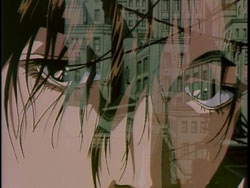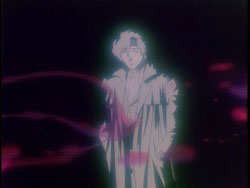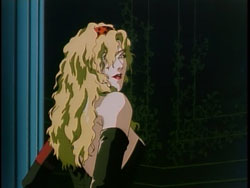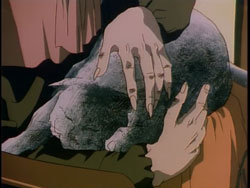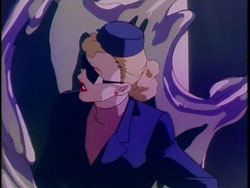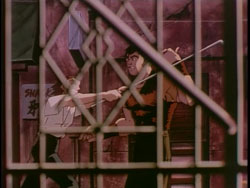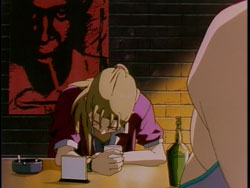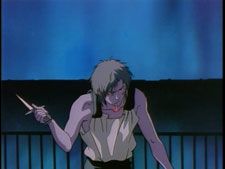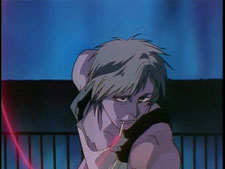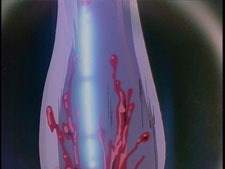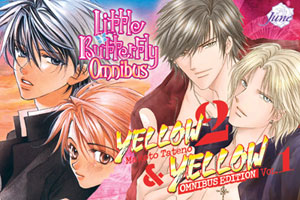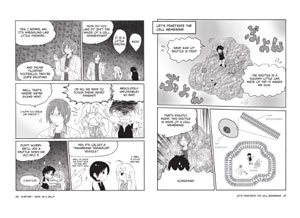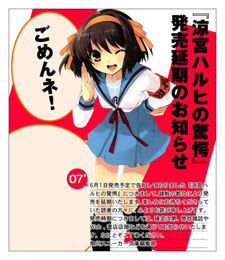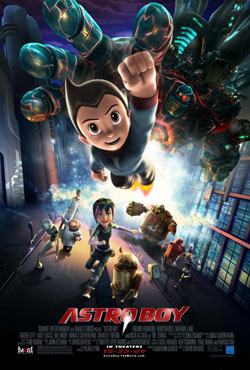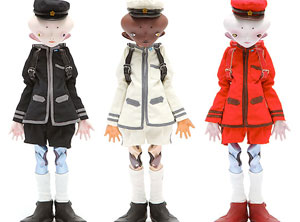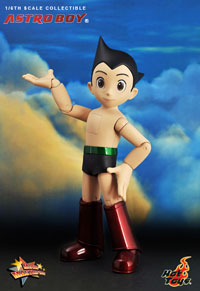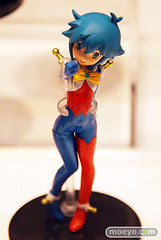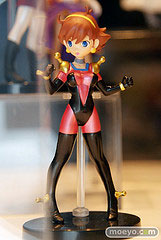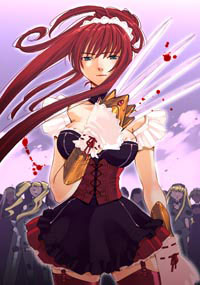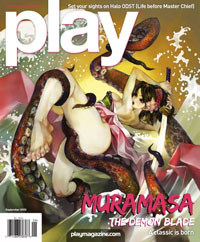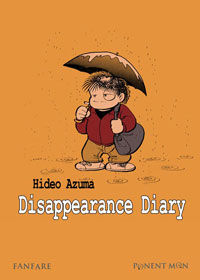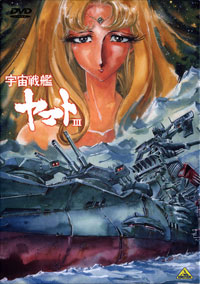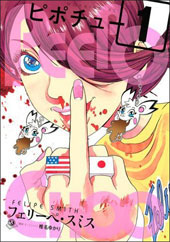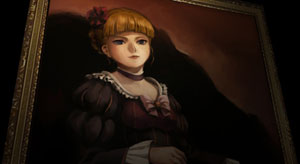 Logo handmade by Bannister
Column by Scott Green
Logo handmade by Bannister
Column by Scott Green
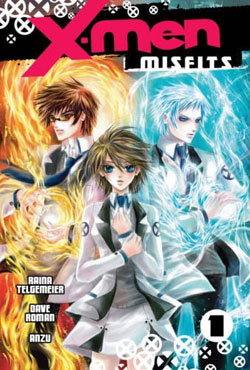
Spotlight: X-Men: Misfits Story by Raina Telgemeier and Dave Roman Art by Anzu Released by Del Rey
X-Men: Misfits is the second collaboration between Del Rey and Marvel to recast the mutant super heroes using manga genre tropes: Wolverine as a wild young outcast in the Naruto tradition, Kitty Pryde as a schoolgirl surrounded by handsome, interested boys, along the lines of Ouran High School Host Club. While some manga can transcend the boundaries of their intended demographics, both of the Del Rey/Marvel manga projects have been works for specific audiences. While capable of appealing to their target reader profiles, they have lacked the hook to convince someone disinterested in premise. My impression of the first, Wolverine: Prodigal Son, was that it was best suited to an audience who knew of the X-Men from the movies or cartoon, and knew of shonen manga from bits of its anime adaptations. Read too much Wolverine and the parent X-Men comics or read too much manga, and paging through Prodigal Son would apt to become an exercise in comparing the work to the traditions that inspired it. Capturing the spirit of popular shoujo (intended for young to teenage girls) manga without blindly aping the model, and leveraging that aesthetic to produce memorable reinterpretations of X-Men's distinctive personalities, Misfits does not require that caveat. Characters and themes remain recognizable, and as such, Misfits is not an exercise of scrubbing away everything but the brand. However, its reimagining of the population and mechanics of an X-Men story are sufficiently distinct from the aims of a super-hero story that Misfits doesn't lend itself to be measured too stringently against the original comic. At the same time, it evokes the feel of Japanese shoujo manga capably enough that readers of the genre will not have cause to reject it. The flaw in this grafting of shoujo and X-Men is that it aims to accomplish too much in too little space. Written for a graphic novel rather than a weekly anthology like most manga or a monthly issue like most super-hero comics, character introductions and plot developments are densely packed into 160 pages. Bouncing from one significant moment to the next, there's little space to stop and appreciate the characters or their situation. The potential humor and chemistry of the situations don't have enough time to fully develop, which is a burdensome liability when it comes to persuading a tentative reader, not enamored with the idea of a teen social drama version of the X-Men. The character of Kitty Pryde was introduced into the X-Men comic by writer Chris Claremont and artist John Byrne in the lead up to their geek-canon ready Dark Phoenix Saga. She was a suburban, Jewish teenage who found that she had the mutant ability to phase through solid objects, where upon the heroic X-Men and their antagonists in the Hellfire Club attempted to recruit her. She came to serve as the rookie and soul of the team, referencing her Jewish heritage and the Holocaust as the ultimate expression of intolerance to deliver the climactic statements in the confrontation with anti-mutant bigot Reverend William Stryker in original graphic novel "God Loves, Man Kills" (loose inspiration for the second X-Men movie) and Magneto. Misfits introduces 15 year old Kitty Pryde as the middle child in a trio of sisters who help their parents run a Chicago restaurant. After spending her school day feeling like an outcast, she stops at the restaurant, where her sisters (in the maid/waitress ensemble of numerous manga) send Kitty home, where her parents are meeting with Mr Lehnsherr (aka Magneto). The stranger explains that he owes a lot to her grandfather, and to repay the debt he'll offer Kitty a scholarship to a private school in Westchester, New York. It turns out that Kitty's mutant ability had been less than a secret, marked by some embarrassing incidents of falling through walls and floors. With that in mind, she quickly gives glum consent to the offer. Fearing that she might fall through a plane, she buckles on a bicycle helmet and knee/elbow pads for the bus ride to New York. She finds a gorgeous campus where she is greeted by half a dozen identical young men looking to carry her bags. The multiple guy, Jamie Madrox proves to be one of the many male students who express interest in Kitty, especially given that she's the only female student on campus. Misfits is keenly aware of the symbolism of the characters, which starts with a title page wallpapered by icons of the characters' powers. Yet, the expression of these symbols isn't always the same as it is in traditional X-Men comics. And while Misfits offers a number of Easter Eggs for comic readers (Kitty Pryde mentions that she'd like to call herself briefly used in the comic code-name "Ariel"), few X-Men characters retain their traditional roles. Professor Xavier is still the headmaster of his school for gifted youngsters. Long time X-Men Storm, appearing in her leather and Mohawk look that debuted in the mid 80's, and Beast, amusingly appearing like a plush badger with a tie around his neck, appear as instructors, but they are joined by traditional arch-villain Magneto. A number of characters who appeared in the comic as antagonists associated with the Brotherhood of Evil Mutants, including Pyro, Blob and Quicksilver join the cast as student. At the same time, employing their power or character concept metaphorically, the personalities and roles of many of the other X-Men are recast in service of Misfits. The clear, sometimes boisterous Iceman becomes cold. Angel descends to the student body as the aloof captain of the Hellfire Club, a group of students who act on Magneto's philosophy of mutant supremacy by spending more time celebrating their power rather than focusing on the education offered by Xavier. As the only girl on the scene, Kitty Pryde has an open invitation to any social circle in the school. The premise accomplishes more than reproduce the genre notion of a "reverse harem" in which a girl is followed around by a group of guys interested in her affection (the above mentioned Ouran High, Wallflower, Fushigi Yuugi). There are too many characters and not enough time for the focus to become a matter of the search for the right guy. Instead, it becomes the story of a young woman with complete social agency. A protagonist with this degree of control is atypical for this sort of high school shoujo, but the complicated path navigated by Kitty as she looks for the correct people with which to associate is certainly fitting for the genre. While Misfits edges towards its super hero origins when dealing with the consequences, it does remain in keeping with the emotional rules set up by the story. Misfits is effective in visually representing itself as shoujo. It thoroughly leverages the graphical vocabulary of the genre, in its use of speed lines short, puffy super deformed shifts in character design for the lighter moments, and symbolic background objects, such as birds or leaves. While it is expressive enough, the art doesn't close in on character faces to the degree that some shoujo does. Instead, it works from context and the full look of the characters. What the characters are wearing often plays a significant role in expressing their role or personality. Misfits ably accomplishes the aim of reworking the X-Men themes of fitting in and prejudice into a high school relationship maelstrom, populated by a sympathetic, if sometimes bland, lead and a host of attractive guys. It then churns until it hits a boil in its climax. Characters are being introduced and situations shifted constantly. If Kitty is contending for control, it's not against any social force, so much as it is to make her decisions before Misfits runs out of space. Ideas such as the middle-child relationship with her sisters come and go so quickly that it is uncertain as to whether they were intended as foundations to build upon at a later time, or quick bits of character shading. Introductions, inefficiencies and gags are all whipped up in the blend, such that they become unidentifiable.
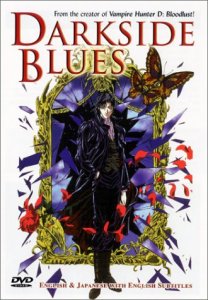
Anime Spotlight: Darkside Blues Released by ADV Films
Anime's blues, Gothic, goth, sci-fi, punk, exploitation flick is back, rescued by Sentai Filmworks/ADV Films following the bankruptcy of Central Park Media. If Darkside Blues weren't so peculiar, it would flirt with an "interesting failure" designation. However, given that there's every indication that what it's doing is intentional, it's pushed into "spectacularly weird" territory. From the ground up, it's architected in such a way that it is not going to be the sort of thorough, involving story that might be hoped for in a movie. Yet, despite being narratively alienating, there are enough artfully bizarre moments in the film to be glad that it is still available and preserved on DVD. Better known in North America for its anime adaptation, Darkside Blues began as a two volume manga series, produced in 1988 as a collaboration between Hideyuki Kikuchi, the light novel pioneer who created Vampire Hunter D, Demon City Shinjuku and Wicked City and Yuho Ashibe, the illustrator of classic 70's horror/tragedy Bride of Deimos. Kikuchi operated in his familiar mode of Doctor Frankenstein, bringing to life a frightfully odd arrangement of unearthed story fragments. In a world of apocalyptic destruction, Darkside Blues pitted a group of 80's punks/youth rebels against the Persona Corporation, through which a powerful family controlled the remains of society, apart from remote regions such as the Himalayas and lawless zones, such as Kabukicho in Shinjuku ("the dark side of Tokyo"). An androgynous figure in Gothic black with notes of Leone Man With No Name, dubbed Darkside, directs a horse drawn carriage into the heart of the conflict and soon proves to be one of the few beings able to stop Persona agents in their tracks.Darkside walks into an already well underway conflict and the story breaks with few of the introduced threads tied off in anything like a satisfying manner. Since the last time either the Darkside Blues anime or manga was released in North America, a fair amount of Kikuchi prose has become available in English. If you've read those works, you'll have a sense of where Kikuchi would explain what's being presented. In this prose, he'd expound on the world's gothic decay and the nature of its social division and factional conflict, balancing Darkside Blue's extravagant oddity with concrete, explicable details. Kikuchi anime adaptations like Vampire Hunter D: Bloodlust have not needed the elaboration offered by their original novels. Aside from A Wind Named Amnesia, these adaptations have been rapid paced, without the ambiguity or incompleteness of Darkside Blues. As a non-exhaustively explored subsection of a longer story, Darkside Blues feels like a chapter was torn out of a book. Given that it has appeared as manga and anime rather than prose, it then becomes illustrations torn out of that chapter. The Darkside Blues anime was produced in 1994. Because this was six years after the manga, its creators must have known that they were working from an incomplete story. That timing quirk is compounded by the fact that 1994 was after the height of the boom of risky OVA and movie anime productions. Odd adaptations were still happening, but in many cases they seemed position to promote running manga series. While the Darkside Blues anime might look like a Madhouse Kikuchi adaptation (Demon City Shinjuku, Wicked City), it was actually produced by J.C. Staff. To find a like exotic horror on their resume, you need to stretch a bit to get to Wrath of the Ninja - The Yotoden Chronicles and a lot to get to Ellcia. Adding to the meta-mystery, character designer/general animation director Hiro Hamasaki has no other anime credits. If the box packaging is correct and the director is Nobuyasu Furukawa, his only other credit is one the three directors on the Earthian OVA (a J.C. Staff production). If Anime News Network's credits are correct and it's Yoshimichi Furukawa, then he has no other attributable anime work. This suggests that some pseudonyms were used in the credits, a not unknown occurrence in anime production. The voice cast includes some familiar names, such as Akio Ohtsuka (Ghost in the Shell's Batou), Kotono Mitsuishi (Evangelion's Misato, Sailor Moon), Kouichi Yamadera (Spike Spiegel), Nozomu Sasaki (Yuusuke Urameshi) and ...According to the DVD credits, the character Darkside is voiced by Natsuki Oh. According to Anime News Network, the character is voided by Natsuki Sakan. And, according to the Anime Encyclopedia, "Darkside himself" is "done by male impersonator Natsuki Akira." Suffice to say, Darkside Blues was evidentially not a vanilla anime production. Set to bluesy harmonica, the anime starts off looking like a gothic grotesque with the exploitative flair of Yoshiaki Kawajiri. In a marble hall gone feral with over growth, the hands of a clock inch towards the number 13 (not a typo all). The vision cuts to a swaying swing framed view of a crumbling farm house where a blonde girl cries. A bomb blows apart a city. The clock hits 13, and a spider wakes up, covering the hall in crimson silk. This resolves to a close up of a sweat drench torso crossed with welts. It grasps for breath, which provokes a sadistic smile from blonde woman. The scene resolves into the movie's most gruesome tableau - which happens minutes into the process. I don't think that even Ninja Scroll was that fast. With a hawk circling the alien airspace of an industrial catacomb, the blonde woman begins interrogating another woman chained to a machine, with her naked chest exposed. It appears that a group of Messiah terrorists have succeeded in damaging a Persona installation, and now of the ruling Hozuki family is aiming to rip some information out of the daring cadre's survivor. To that effect, the blonde shoves a pair of spikes into her victim’s bare chest. Blood flows down the spikes onto the floor, and after convulsing, layer's of the victim’s body begin turning transparent, then the Transmutation Machine begins slowly turning the victim’s body into gold. Darkside Blues yeilds an arrest sizzle reel full of bazooka babies, death by finger flick, orbital laser barrage, and Sailor Moon style rose toss attacks. In its action scenes, it yields the kind of spectacle that could be hoped for from well budgeted cell animation. It's fluid and complex. A guy will leave a glowing trail from his cigarette as he falls back, slices off the arm of Pierrot-looking attack mutant, then, when the freak launches a missile from the stump, the first party deflects it with his knife. However, these high spots are not leveraged in such a way as to make Darkside Blues an effective work of horror action. It doesn't build to these or establish that they are something to anticipate. The moments that fans of those Madhouse grisly spectacles hope for appear at seemingly random spots in the movie, rather than as punctuations for developed confrontations. Plot operates in a similar fashion. Certain characters are unmistakably important, but the movie never establishes what to watch for as plot threads are thrown out but rarely woven together. Even rewatching the movie knowing the meaning of relationship and symbols, it is still too obtuse to care about. Ultimately, it's difficult to decide whether it's the elements that lead nowhere or the ones that are resolved which are more dissatisfying. In that there is something interesting framing every shot and every movement of the movie's diverse range of character designs, it's a well directed movie. Even the toe curling quasi-English blues song sure to imprint a negative impression on most viewers is accompanied by an inventive look at the damage to Tokyo that eclipses into psychedelics. However, lacking momentum or meaningful resolution, enjoyment of the movie is derived from detached appreciation rather than involved excitement. While few will embrace the movie, in the studied movements of a woman pulling at a house plant in the midst of an unwelcome turn in a conversation, or a glass marble which reflects the world upside down, then being reflecting an alien landscape, the Darkside Blues yields an abundance of well crafted animation worth appreciating.
Upcoming in North America
Digital Manga Publishing Digital Manga Publishing has announced their newest reissue, the Little Butterfly Omnibus! Collecting the now out of print three volumes of Little Butterfly, the omnibus edition spans over 560 pages As a special thank you to to fans, Digital Manga Publishing will make exclusively available at Yaoi-Con only, a limited number of the Little Butterfly Omnibus for purchase. The street date is not until February 2010, and we will only be making the book available for Yaoi-Con attendees. Yaoi-Con takes place over the Halloween weekend, October 30-November 1, in beautiful San MateoLITTLE BUTTERFLY OMNIBUS, Rated M+ (for ages 18+), MSRP: $29.95, Available: February 15, 2010, 5.87"x 8.25", 560 pages!, June' Imprint Kojima’s friendly attitude and upbeat, playful innocence help to guarantee his status as a well-liked boy. But the brooding Nakahara is the exact opposite! A shy wallflower, he seems aloof and is constantly alone...until Kojima suddenly steps into his dark, painful world. When the time comes to take flight, will the two boys simply escape to a fantasy free of pain and suffering, or can they break out and soar into a bright, exciting future of their own? Little Butterfly spreads its wings and sets off on a flight path full of love, longing and plenty of tender moments. Watch as a brand-new friendship slowly grows from a fragile bond to a forceful partnership between two distinct and special souls. Even the smallest of creatures dream of soaring beyond the mundane world, YELLOW: OMNIBUS EDITION VOL. 1, Rated M+ (for ages 18+), MSRP: $19.95, Available: November 18, 2009, 5.87"x 8.25", 385 pages!, June' Imprint Taki and Goh share just about everything – their apartment in the city, their job as elite drug “snatchers” and even dinner duty. But hot Goh wants to go much deeper undercover with his gorgeous partner. Too bad Taki doesn’t swing that way...or does he? If yellow is the warning color, will this team finally end up in-the-red (and in bed)? Boys will be boys, and the hot guys of Yellow are no exception. An illicit thrill-ride from cover to cover, this hip drama turns up the heat on every page and guarantees to get your heart fired-up! Back by popular demand, this limited edition omnibus collects volumes 1 and 2 of the original series, with some unseen artwork and unpublished content. YELLOW 2: EPISODE 1, Rated M+ (for ages 18+), MSRP: $6.95, Available: November 18, 2009, 5.13"x 7.19", 64 pages, June' Imprint Taki and Goh, the elite drug "snatchers" are back! In July of 2005, DMP introduced one of the most popular creator & ground-breaking series: YELLOW to the yaoi industry, cementing Tateno as a yaoi fan favorite. Fans have eagerly waited for more, and finally, Makoto Tateno has created a mini sequel series starring her two beloved characters, which has never been published in print, until now. No Starch Press No Starch Press has released The Manga Guide to Molecular Biology (No Starch Press, August 2009, 240 pp, ISBN 9781593272029) In the book, readers tag along with Ami and Rin as they journey inside the body's cells and nuclei. As they travel, they learn about core topics in molecular biology like protein synthesis, amino acids, cell division, DNA replication, and genetics. Along the way, they experience chemical reactions first-hand and even meet entertaining characters like Enzyme Man and Drinkzilla, who show them how the liver metabolizes alcohol. Topics include The organelles and proteins inside cells, and how they support cellular functions Transcription and translation, and the role genes play in synthesizing proteins The pieces that make up our genetic code, like nucleotides, codons, introns, and exons The processes of DNA replication, mitosis, and cytokinesis Genetic technology like transduction and cloning, and the role of molecular biology in medicine Whether readers need a molecular biology refresher or are just fascinated by the science of life, The Manga Guide to Molecular Biology will give them a uniquely fun and informative introduction. Tokyopop Tokyopop's Fall line-up includes Domo the adaptation of NHK TV's fuzzy brown monster mascot The cuddly and irreverent mascot of Japan's NHK TV comes to life in a full-color collection of hilarious, absurd, and outlandish stories. Follow Domo has he takes things one step at a time, embraces the littlest things in life, and learns not to believe everything he sees on TV! MAD LOVE CHASE (due in September) MAD LOVE CHASE by Kazusa Takashima, the creator of WILD ROCK and MAN'S BEST FRIEND. MAD LOVE CHASE follows the adventures of Kujo Yamato, a prince of hell who has fled to the human world as an average high school kid looking to avoid an arranged marriage back home. Hell, however, is scrambling to find the prince and has sent their finest warriors, plus Kujo's snubbed fiancée, after him! MARIA HOLIC by Minari Endoh, the creator of DAZZLE (due in September) This hilarious manga tells the story of Kanoko Miyamae, who enrolls in an all-girls school hoping to find the love her life and avoid her allergy to boys. She falls for the first cute girl she meets, but unfortunately that cute girl turns out to be a sadistic crossdresser! KARAKURI ODETTE by Julietta Suzuki (due in October) Follows the life of Odette, an android designed by the brilliant Professor Yoshizawa. Odette is determined to find out the difference between human and robot, and the only way to find the answer is to pretend to be human--and enroll in high school! CAUSE OF MY TEACHER by Temari Matsumoto, the creator of KYO KARA MAOH! and SHINOBU KOKORO (due in October) CAUSE OF MY TEACHER is a collection of short stories featuring romance with a variety of cute couples. As a special bonus, this volume includes an extra story from the world of SHINOBU KOKORO. LIBERTY LIBERTY by Hinako Takanaga, the creator of A CAPABLE MAN, LITTLE BUTTERFLY, CHALLENGERS, THE DEVIL'S SECRET(due in November) In LIBERTY LIBERTY, a young man named Itaru drunkenly falls into a trash heap, from which he is saved by a camera man. When Itaru breaks his rescuer's video camera, he feels guilty. So Itaru decides to help pay off the debt--but he's far from helpful at all! MIKANSEI NO. 1, from the creator of ST. LUNATIC HIGH SCHOOL (due in November) MIKANSEI NO. 1 introduces us to a girl born just a little ahead of her time: She lives in the 23rd century, but loves the 21st century! Luckily for her, she finds a mysterious object that sends her back to our time and right into the spotlight! THIS UGLY YET BEAUTIFUL WORLD, by GAINAX and Ashita Morimi and based on the hit anime (due in December) follows a high school boy who finds and befriends a mysterious girl emerging from a cocoon. MADNESS by Kairi Shimotsuki, the artist of SENGOKU BASARA RANSE RANBU based on the hit video game DEVIL KINGS. MADNESS is set in 3000 A.D., when mankind has been nearly destroyed by natural disasters. Only a pretty young priest and a mass-murderer can save the world--and only if they team up! .HACK//ALCOR by Rena Izumibara and Takashi Tanegashima, the artist of .HACK//GNU. Continues the .hack series from its main story .HACK//GNU. .HACK//ALCOR takes place in the online game "The World" and follows Nanase, a shy player who belongs to a newbie-helping guild in order to get closer to the guild master, on whom she has a major crush. But will love get in the way of her ability to save her friends when they are targeted by player-killers? VIZ Media VIZ Media will release the Uncut DVD Box Set for the animated romantic rock and roll melodrama, NANA, on September 8th. The 3-disc set featuring 12 episodes will be rated ‘M’ for Mature Audiences and carry an MSRP of $59.90 U.S. / $85.99 CAN. The first box set will also include an exclusive NANA guitar pick. The NANA anime is based on the popular manga by Ai Yazawa, follwing the adventures of two girls both named Nana. While they share the same name, they couldn't be more different. Nana "Hachi" Komatsu follows her boyfriend to Tokyo in the hopes of finding a fresh start, while Nana Osaki, who arrives in the city at the same time, is a punk rock beauty with the ambition for making it big in the world of rock and roll. Although these two young women come from opposite backgrounds, they quickly become best friends while chasing their happiness and dreams. * VIZ Pictures has announced the DVD release of Traveling with Yoshitomo Nara – NEW PEOPLE ARTIST SERIES, Volume 1 on September 15th. The DVD will carry an MSRP of $24.92 U.S. / $35.99 CAN and will be distributed in North America by VIZ Media. Produced by VIZ Pictures, the NEW PEOPLE Artist Series is an intriguing collection of documentaries that each highlight a renowned modern Japanese pop artist who utilizes unique world views and inspirations to create captivating works of art. The series is an extension of the NEW PEOPLE entertainment destination, located in San Francisco, which brings the latest examples of Japanese popular culture to North America through film, art, fashion, and a variety of specialty boutiques. Traveling with Yoshitomo Nara was directed by Koji Sakabe and captures the journey that the artist, Yoshitomo Nara, took during the creation of his exhibit, AtoZ, in his hometown of Hirosaki, Japan. The film is notably narrated by Aoi Miyazaki, an up-and-coming Japanese actress who appeared in the acclaimed manga-inspired film NANA (VIZ Pictures). Yoshitomo Nara’s work has captured the attention of the international art world and his cartoon-like girl images with characteristic big heads, chubby-faces and slanted eyes have become icons of the artist’s style. His paintings and sculptures have been auctioned at Sotheby’s and his sculpture, Light My Fire (2001), sold for over $1.1 million. Viz DVD distributor Warner Home Video lists that Monster set 1 will be released on 12/8 for $59.90NAOKI URASAWA'S MONSTER BOX SET 1 What would you do if a child you saved grew up to be a monster? An ice-cold killer is on the loose, and Dr. Kenzo Tenma is the only one who can stop him! Tenma, a brilliant neurosurgeon with a promising future, risks his career to save the life of a critically wounded young boy named Johan. When the boy, now a coldhearted and charismatic young man, reappears nine years later in the midst of a string of unusual serial murders, Tenma must go on the run to uncover the story of Johan and stop the monster he set loose upon the world. 12/1 HUNTER X HUNTER BOX SET, VOL. 4 12/8 NARUTO SHIPPUDEN VOL. 4 Warner Home Video 12/15 ROBOT CHICKEN: SEASON 4 Watson-Guptill Watson-Guptill will released Shoujo Art Studio by Yishan Li on September 8th for $25.99 An accompanying CD includes PSD templates from page layouts and speech balloons to backgrounds, tones, and effects.
Upcoming in Japan
Previews New trailer for Sunao Katabuchi's 'Mai Mai Miracle' Assault Girls - the new live action Mamoru Oshii film The live action adaptation of dirty uncle of manga Go Nagai's Abashiri Ikka (The Abashiri Family), concerning a family of gangers, - due to hit theatres in November Anime via Anime Vice Marvelous Entertainment is said to adaptating Shoutarou Mizuki's light novel Ichiban Ushiro no Daimaou, set 100 years in the future in a society that won a magic war with demons Volume six of Yoko Nihonbashi's girl's volley ball manga Shoujo Fight will be packaged with an original anime DVD Prose Nagaru Tanigawa has begun work on new light novel “Suzumiya Haruhi no Kyougaku / The Shock of Haruhi Suzumiya” after a hiatus of several years
Going Hollywood
According to Saiyan Island James Marsters responded to a question at the Monster Mania convention with the detail that DragonBall: Evolution had a $30 million budget, and not the reputed $100 million Wired goes indepth on Imagi's Astro Boy adaptation And the final poster
Upcoming in Japan
Fall 2009 season preview
The Business
TOKYOPOP has confirmed that rumored to be entering the US manga-market mega-publisher Kodansha has opted not renew their licenses. The Japanese publisher Kodansha, from whom TOKYOPOP has licensed many terrific series over the years — Chobits, Love Hina, Samurai Deeper Kyo, Rave Master, Initial D, Kindaichi, Life, GetBackers, and Love Attack, to name a few — has decided to let all existing contracts with TOKYOPOP expire on all manga series that they have licensed to us. As a result, Kodansha will not renew any licenses with TOKYOPOP for any new manga volumes. What does this mean? TOKYOPOP will not be allowed to complete the publication of any series that is currently in progress; in addition, TOKYOPOP will not be allowed to reprint titles after the current inventory has been sold out, so once these series are sold out at retail, they will not be available for consumers to purchase. The reasons for Kodansha’s decision were not communicated to TOKYOPOP. We have received many emails and phone calls about titles related to this announcement, and given the nature of the negotiations, we could not definitely answer any of those questions until now. We love all of these series, and we are disappointed that we will not get to enjoy the outcome of some of our favorite manga. We hope to see these series completed some day…. However, if they are ever published again, they will not be published by TOKYOPOP. Precocious Curmudgeo lists effected titles About.com:manga analyses Anime Vice spoke to Tokyopop* AWN Notes the Media Development Research shows that the animation business in Japan only made $2.24 billion in 2008—that’s a $300 million drop from a record $2.54 billion in 2006. The number reflects both domestic and foreign movies, TV shows and DVDs.* Online figure retailer Twin Moon Anime is closing shop in face of the challenging economy* Viz Media parent companies Shogakukan Inc., Shueisha Inc. and Shogakukan-Shueisha Productions Co., Ltd. (Shogakukan & Shueisha Group) announced their joint acquisition of Kaze S.A.S. (Kaze) and Anime Virtual S.A. (Anime Virtual), two of Europe’s leading distributors and licensees of Japanese animation. Paris-based subsidiary VIZ Media Europe (VME, President, John P. Easum) will helm the group’s Europe activities, with Kaze and Anime Virtual now part of its stable. Prior to acquiring Kaze and Anime Virtual, Shogakukan & Shueisha Group managed VME’s European operations through its U.S. based subsidiary VIZ Media, LLC (VMC, President, Hidemi Fukuhara). This acquisition provides Shogakukan & Shueisha Group with several critical tools: Direct DVD publishing and distribution in France and Germany. TV broadcast and distribution through various new platforms and technologies. Development and licensing of consumer products. Direct manga publishing and distribution ability throughout French speaking Europe. Innovative brand building across a full spectrum of media, including manga publishing, animation licensing, animation broadcasting, consumer product licensing and new digital platforms. The new company, which will be wholly owned by Shogakukan & Shueisha Group, will integrate VME, Kaze, Anime Virtual and their subsidiary companies under a unified infrastructure and administration. John P. Easum, has been named President/Gérant of the new company and will head up the group’s European operations. The head office will remain in Paris. Cedric Littardi and Nicolas Weber-Krebs have been appointed managing directors.* Don MacPherson on the return of King City manga formerly published by Tokyopop as an original graphic novel, now running as separate issues from Image
Cool Figure News
Superflat artist Takashi Murakami is working with Medicom Toys to produce figures based on his bioengineered character inochi. The figure will come in 5 different versions, each dressed in a different outfit. The figures will be each limited to 200 pieces and they will go for around 1500 USD.* Hot Toy's Astro Boy releases include 1/6 scale Astro Boy collectible figure The Astro Boy Collectible figure features: - Approximately 9 inches tall - Over 22 points of articulation - 2 sets of interchangeable posing hands - Open chest with positive "blue" energy inside - Battery-operated illuminated eyes for X-ray vision mode - Interchangeable arm cannons - Interchangeable rocket boots - Figure display base featured with Astro Boy movie logo Product shown is not finalRelease date: Q4, 2009 Astro Boy Vinyl Figure - Approximately 12.5 inches tall - allows limited movements Release date: Q4 , 2009 * Dark Horse has announced a Target exclusive Domo Qee these new colors include solid yellow and solid orange, as well as translucent black and translucent blue. In addition, Dark Horse also announces a color change in the upcoming Dark Horse Deluxe line of 4” flocked Domo vinyls. The previously announced Raging Red color has been changed to Mint Green. The edition size will remain at five hundred pieces. * Black Lagoon figureson the Evangelion front Neon Genesis Evangelion Kubrick Figures Display Case Ayanami Rei pullip Asuka Langley Evangelion pullip Customized face Gundam Char Aznable figure - Char Coffee mug For fans of artifacts of ephemera, Getter Robo Tin Walker a Tekkaman window-up cycle - Junior Machinder Box Art Evangelion omake Revoltech Getter 1, Getter 2 and Getter 3 reviewed Revoltech Yamaguchi Getter Dragon & Neo Getter 1 New Images Revoltech Ulta Magnus review Nu Gundam Bust Display Closeups & Others from Chara Hobby 2009 On the Macross from VF-25 Ghost & Weapons Set (Tamashii Web Exclusive) Macross F 1/72 VF-25 Deculture! Decal Ver. & Ichiban Premium New Images Donald Duck x Transformers Bumblebee (near bottom) Horrifying Half Age Girls Gundam Heroine
Digital Distribution News
The latest episode of the IRrelevant Astronomy video podcast concerning the NASA's infrared Spitzer Space Telescope is now online. Robot Astronomy Talk Show: Back in Time Linda Hamilton attempts to foil the robots' plans of Universal conquest; meanwhile, Dean Stockwell explains the concept of "looking back in time" at objects in space, and how it helps astronomers understand how the Universe has evolved. Starring Ed Wasser as the voice of IR-2. (9:11)* Bandai Visual announced that super group JAM Project (known for their mecha work) now have songs on iTunes No Border (English ver. coupled with "HERO") SKILL (coupled with "FOREVER & EVER") GO!! / DEPARTURE (two songs) VOYAGER Danger Zone (coupled with "It's Emotion") DRAGON (coupled with "No Serenity") The songs are ring tone enabled* 1980 Astro Boy on Hulu Voltron on YouTube* Bandai Entertainment and Crunchyroll are offering mecha anime EUREKA SEVEN (episodes 1-50; subbed and dubbed) The live action drama adaptation of Suwa Ayako's Japanese vampire fantasy RH PLUS is also now streaming on Crunchyroll* Yomiuri Shimbun on unauthorized fan translated manga or scanlations
Anime x Games
Wired reports that Studio Ghibli's collaboration with game makers Level 5 has been pushed back to 2010. Speaking of bumped, the Studio Ghibli game Ni no Kuni (The Another World) is now on for a 2009 release. Apparently it’ll use a 4 GB DS cartridge, the biggest ever, to squeeze in all the orchestrated soundtracks. Damn. I really want this bad, but that just made a U.S. release even more difficult: Now, whoever steps up to the plate is not only going to have to eat the cost of a giant hardcover book, they’ll have to pay for a massive ROM, too. Level 5 also announced Fantasy Life, an RPG scored by Final Fantasy composer Nobuo Uematsu.* Kotaku previewed the Sky Crawlers: Innocent Wii game, and speaking of Wii games Ju-on Screenshot of Kaiju Busters for the Wii* Anime style digital collectable card game Alteil has put out the Set 5 Cards with 60 news cards featuring art from Rei (Code Geass Manga), Masaki Hirooka (Culdcept Saga, Sonic and the Secret Rings) and Kazuno Yuikawa (Aquarian Age, Ragnarok Online) amoung others. See here for more* A trailer of the* Kristen Ball speaks about her Astro Boy game work* Indie game studio, Rockin' Android has launched doujin 1-2 player 2-D shooter PC game QLIOINE (Japanese name Qualia) available for download on Gamersgate.com and Direct2Drive.com for $9.99.* for tentacle fans, 1Up's Shane Bettenhausen comments of the Fisherman's Wife based Play cover for Wii game Muramasa: The Demon Blade
Event News
Evangelion1.0 to be screened at the Japan Information and Culture Center, Embassy of Japan. DC Anime Club in collaboration with Japan Information and Culture Center, Embassy of Japan Present screen Evangelion 1.0 Wednesday September 9, 2009 6:30 pm as part of inaugural showing for a new film series based on both Anime (Japanese Animation) and Manga ( Japanese Comics).* Superglorious and the New York Anime Festival (NYAF) today announced the Far East To East Showcase (FETES) 2009 night of music performance. FETES takes place in The Studio at Webster Hall (125 East 11th Street, New York City) on Sunday, September 27. Doors open at 5:30 PM with FETES '09 scheduled to kick off at 6:30 PM. The FETES musical lineup includes Kokusyoku Sumire, Echostream, Swinging Popsicle, and Gelatine. Tickets are $10 in advance and $15 the day of the show and available now at www.ticketweb.com and www.websterhall.com.* Jason Thompson (Manga: The Complete Guide) announced his schedule for Kumoricon in Portland, Oregon on Labor Day Weekend (September 4-7).* Pop Japan Travel announced a the Jump Festa 2010 tour - Shueisha/Shonen Jump Comics in Japan showcases new manga and anime projects from Shonen Jump, as well as exhibits such as Square Enix, Nintendo and Koei . The Jump Festa tour is $2298, tax, fuel, and hotels included, with a $100 early-bird discount. The tentative dates for the Jump Festa tour are December 15th-December 23rd.* Japanese rock group GLAY will tour the US in early September starting at The Fillmore (San Francisco; Sept. 9, 2009) and with two shows in Hollywood at the House of Blues Sunset Strip (Sept. 11 and 12, 2009).* Photos of the Academy of Motion Picture Arts and Sciences’ ANIME! exhibition
And the Award (or Nomination) Goes To...
Afro Samurai: Resurrection's art director, Shigemi Ikeda was honored with the Primetime Emmy Award for "Outstanding Animated Program (for programming one hour or more)" by the Academy of Television Arts & Sciences.* About.com:manga notes that the Small Press Expo's list of Ignatz Awards includes Hideo Azuma's Disappearance Diary in the Outstanding Graphic Novel and Outstanding Story categoriesBorn 6th February 1950 in Hokkaido. He moved to Tokyo where he was assistant to Rentaro Itai and debuted in manga in 1969. Throughout the 70´s and 80´s he produced a large body of work in many genres including the comedies FUTARI TO GONIN (Two People and Five) and YAKEKUSO TENSHI (Desperate Angel), the Science Fiction Seiun (Japanese Hugo) Award winning FUJOURI NIKKI (Absurd Diary) and is also known as the father of Lolicon manga. But the pressures told and, in 1989, he ran away from his responsibilities and went homeless. After this experience and his eventual return to normal life, he then repeated the cycle in 1992, this time becoming a gas pipe layer in another town. Later, in 1998, his alcoholism was so bad that he was forced into rehab. This book is his expression of those three periods of his life told, not in a deep or depressed way but, as befits his nature, in a buoyant and cheerful cartoon art and is a welcome addition to the "personal manga" genre. In 2005, SHISSOU NIKKI (Disappearance Diary) was awarded the Grand Prize from the 9th Japan Media Arts Festival Manga Division and the Excellence Price at the 34th Japan Cartoonists Association Awards.
Event News
NCM Fathom and Bandai Entertainment will be presenting Eureka Seven – Good Night, Sleep Tight, Young Lovers in a special one-night event on Thursday, September 24th at 7:30 p.m. local time. The English dubbed event will feature an exclusive behind-the-scenes look at the creation of Eureka Seven – Good Night, Sleep Tight, Young Lovers at studio BONES (“Sword of the Stranger” and “Fullmetal Alchemist”) as well as never-before-seen interviews with several English voice actors including Johnny Bosch (Renton) and Stephanie Sheh (Eureka), audio director Tony Oliver (Robotech, Gurren Lagann) and director Tomoki Kyoda who explains the bold new vision and the “regeneration” of the Eureka Seven storyline. Tickets for this special event are available at www.FathomEvents.com and participating theater box offices. For almost half a century, mankind has battled a mysterious organism from space called “EIZO.” In 2054, Renton, a young soldier, boards a fighter aircraft battling “EIZO.” The young soldier heads for the battlefield with a dream: to rescue his childhood friend, Eureka, who was kidnapped eight years ago. Fate, however, brings tribulations to test the young love between Renton and Eureka as the final battle with “EIZO” approaches. Exclusive to this in-theater event is an interview with director Kyoda who explains the creative choices made while working through the production of Eureka Seven – Good Night, Sleep Tight, Young Lovers. Audiences will hear about the unique challenges the audio director faced while creating the English-language version and see how it was recorded at Bang Zoom Entertainment – one of the premiere U.S. recording studios for anime recently featured on “The Tonight Show with Conan O’Brien.” Other voice actors interviewed for – and appearing in – this event include Crispin Freeman (Holland), Kate Higgins (Talho) and Kari Wahlgren (Anemone).
Worth Checking Out
Insight Before you completely tire of Ponyo, read Joe McCulloch's The Populous Sea Serdar Yegulalp on the Paprika novel Tsutsui’s eclectic mixes of fantasy, SF, black comedy and other genres have been only sporadically presented in English; Paprika itself was only recently translated, and isn’t even directly available to readers in the United States yet. That’s a shame, because the book’s a broadly entertaining introduction to an author who hasn’t yet gotten his due domestically. He’s been superficially compared to Haruki Murakami or J.G. Ballard, although he’s more playful than the latter and more formally grounded in genre than the former. I agree with Reverse Thieves read Guin Saga! On The Asia-Pacific Journal: Japan Focus, The Letter as Literature's Political and Poetic Body Just as in other countries, people in Japan have been lamenting since the 1980s (if not much longer) that young people no longer read the classics of world literature. First it was the culture of manga and television that was seen as the culprit; later it was the internet, computer games and obsessive text messaging. The number of books sold each year has actually been rising, because manga, the autobiographies of TV stars, internet literature and even text-message literature have come out in book form—but nonetheless people have been complaining that the old canon of world literature is no longer being taken seriously. And so this new Karamazov boom was a pleasant surprise. But I asked how this new translation of the novel could be so different that suddenly hundreds of thousands of Japanese readers were in such a hurry to buy it and were reading it with such enthusiasm. Even in times when literature supposedly had many more readers than today, Dostoevsky was never a bestseller. Publishers Weekly previews the Last Gasp release of Suehiro Maruo’s The Strange Tale of Panorama Island. The book is due out in spring of 2010 and will be translated and edited by Ryan Sands and Last Gasp publisher Colin Turner—the same team who worked on the American release of last year’s alternative manga Tokyo Zombie. Maruo’s The Strange Tale of Panorama Island is unlike his earlier work and both Sands and Turner believe it will find a wide readership. “Maruo is a master draftsman.” Sands said of the mangaka’s clear line work which will remind readers of Jiro Taniguchi and Kazuichi Hanawa. “Panorama Island is Maruo’s most beautiful and mature work to date. ” “He’s an incredibly skilled artist.” Turner said. “And this is a beautifully rendered otherworldly story.” Turner and Sands aren’t alone in their thinking. By pairing himself with the highly esteemed detective and mystery writer, Edogawa Rampo, Maruo has brought his work to a new level of recognition. He was awarded the Osaumu Tezuka Prize in the New Artist category for Panorama Island earlier this year. The mangaka is currently working on another Rampo adaptation, Caterpillar, which is being serialized in Japan. AniPages Daily on The Restaurant of Many Orders and Kenji Miyazawa anime Many of the best directors working in animation in Japan have adapted early 20th century poet Kenji Miyazawa's timeless short stories. The last film made by Japan's pre-eminent indie animator of the 70s and 80s, Tadanari Okamoto, was an adaptation of Kenji's The Restaurant of Many Orders. Okamoto died in 1992 midway through production, and the film was brought to completion the next year by his longtime friend and fellow indie animator Kihachiro Kawamoto. A trailer for the adaptation of Miyazawa's Night on the Galactic Railroad ... also Rintaro's Take the X Train Commentary on Ooku, an alternate history in which the majority of Japan's populous is killed by plague, is a bit more interesting and a bit less effusive than I expected review's of note include Noah Berlatsky Kate Dacey David P. Welsh Charles Solomon on Viz's release of Hayao Miyazaki's 'Starting Point' THEM Anime Reviews on cycling anime Nasu: Summer in Andalusia Epsidoe 100 of the Anime Today podcast features an Anime Iowa 2009 special – featuring new interviews with convention guests, including Robert Axelrod, Greg Ayres and Studio Capsule’s Emily DeJesus, chats with cosplayers and convention attendees On Sci-Fi Japan Tim Eldred - SPACE BATTLESHIP YAMATO III: The Ground ShiftsSubatomic Brainfreeze introduce Bakemonogatari How to Survive a Macross Missile Mass Michelle Smith on Little Fluffy Gigolo Pelu, Vol. 1 Continuing World introduces Yamamoto Yohko - zany anime comedy meets the Last Star Fighter Andrew Cunningham introduces Bokke-san I've maintained for several years now that Yoshiyuki Nishi has the single best creature design in all of manga. Kekkaishi is the closest, but Kekkaishi is resoundingly sane, and Nishi is BAT SHIT. The US version of Muhyo and Roji is neck deep in prime material, the most astounding chunk of the series...and has no buzz at all. Likewise, Bokke-san, his follow up, lasted two volumes, a victim of Jump's ruthless chopping block. Chris Beveridge and John Zakrzewski spoke to mecha music super group JAM Project In conjuction with the release of their new issue (the Eva 1.0 cover) Otaku USA has posted When They Cry 3: Umineko no Naku Koro ni (“When the Seagulls Cry”) Let Me Play (Eva Games) Among the Stars - Going mental like a virtual Shinji Detroit Metal City - Live and in the devil's flesh! Central Park Media: More "Quality" than Pirsig - The thin line between bad and unforgettable Kurau: Phantom Memory-The patient aren't always rewarded B

